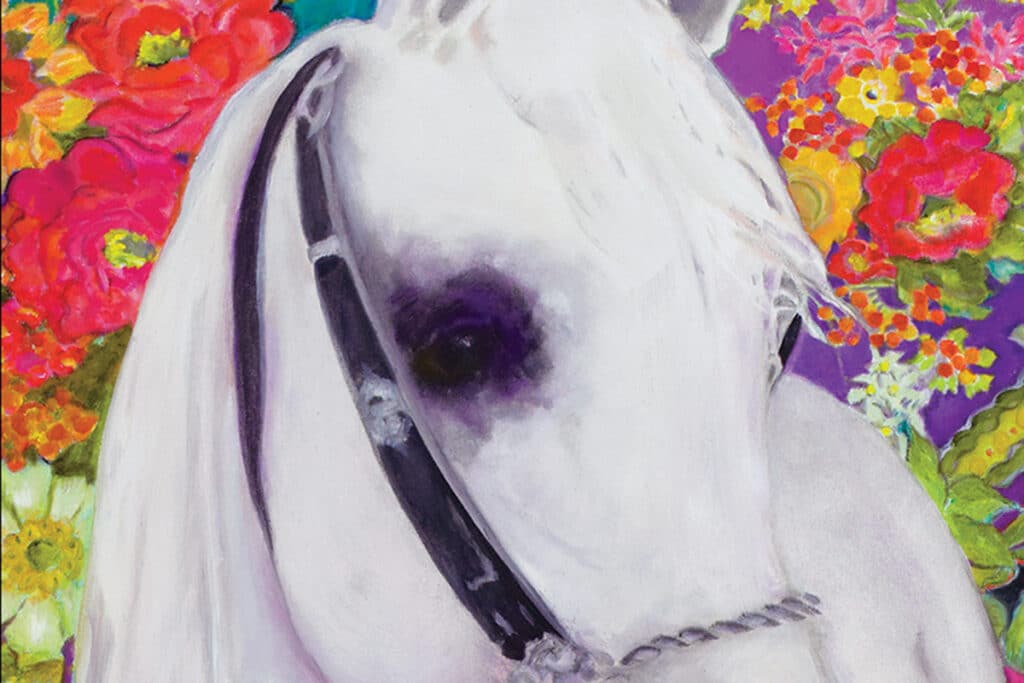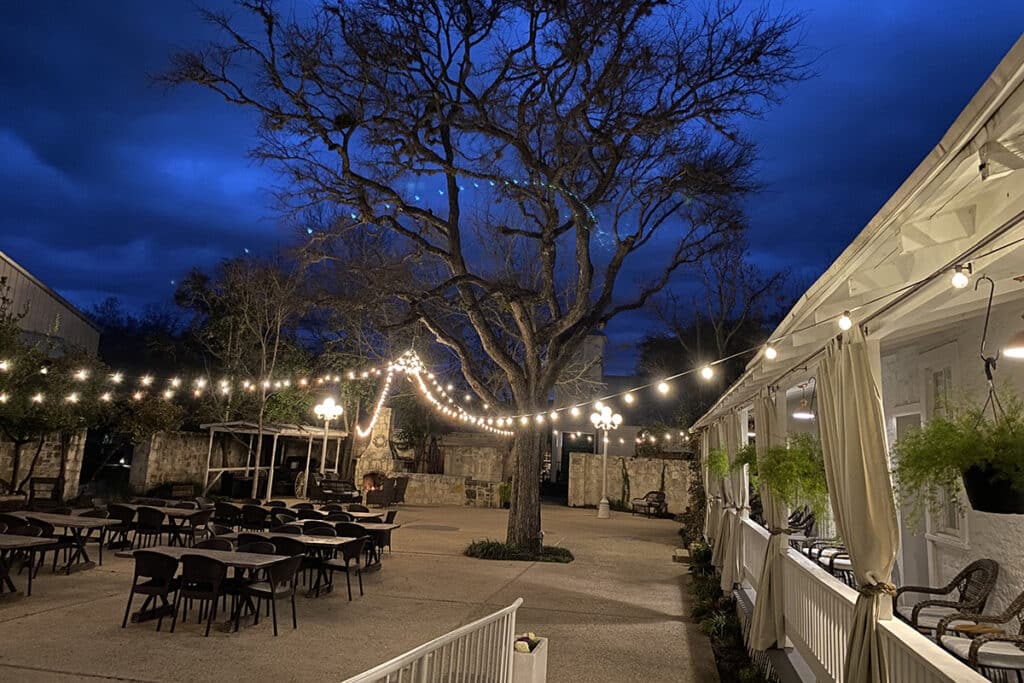If she is not traveling, Lisa Fittipaldi can usually be found in her studio, painting away for long hours at a time. It doesn’t matter that right now her makeshift studio is just a corner room in the house she and husband Al are renovating in the King William area. Painting is something she needs to do for her own good.
“I have to paint to give myself tranquillity in this chaos,” explains the petite artist, referring to the construction work around her. “I am back to my roots, painting shapes. It’s just a fun painting.”
What got her going this time was finding some over-the-hill peppers in her fridge. Why not, she thought; she would paint green peppers. But after drawing a bunch of these bulbous vegetables, she decided that the composition needed more variety in terms of sizes and shapes. So one of the peppers became a squash, and then she added grapes, a lemon and a few other things.
On this particular morning, Fittipaldi is concentrating on shading and reshaping one of the peppers. She accentuates the lines between the sections of the vegetable and expertly dabs a little red paint here and a touch of white there to create a natural look.
Watching her at work, one would never guess that Fittipaldi is blind. Yet she is — not just legally blind but profoundly blind. What’s more, she had not been an artist before she went blind back in 1993 at the age of 47. She learned everything she knows about visual art in the last 10 years, after reconciling herself to her misfortune and resolving to create a new life for herself.
Today, Fittipaldi is one of the very few, if not the only, profoundly blind painter in the world. Although she is not part of the contemporary art scene in San Antonio, she has developed an international following of her own, selling her work through her Web site and through the Gallery Soco in Austin. Against all odds, Fittipaldi has strived to paint in a realistic style, aiming for more and more precision and complexity over the years and defying all expectations.
Leaning against the wall in her studio is a street scene populated by a number of human figures. She has been working on that on and off for a while, she explains, but is not happy with the result. Right now, painting people is too much of a challenge, so she will have to return to it at a later date.
“I have two goals for the future,” says Fittipaldi. “One is to be able to navigate the streets and the subways of New York without a cane, and the other is to paint a thousand people gathered in the Ganges River.”
The opportunity to achieve the first goal may present itself in September, when her one-woman show is scheduled to open in New York City under the auspices of A Gathering of the Tribes, an organization that gives “underexposed artists” a chance to be seen.
She is not yet sure what she will be showing in the Tribes show, however.
“I don’t focus on the deadline,” she says. “Process is more important to me than the finished product. Mos likely, I’ll do something related to what I need to learn, like how to navigate this new house. Paintings may become (images of) one person doing something, something that would express my elation that I can find my toothbrush, for instance. Others may be a series of objects, street scenes, whatever is in my head at the time that I start painting.”
In her pre-blindness life, Fittipaldi was first a nurse and later a CPA whose focus was primarily on making enough money to be in control of her own life. In her 2004 book, A Brush with Darkness: Learning to Paint After Losing My Sight (written with Laura Torbet), the artist describes how the world went black one morning on her way to work. Although her vision returned that day, the disease that caused the blackout, vasculitis, progressed in the next six months until she could no longer drive or work. Vasculitis is an autoimmune disorder that attacks blood vessels, impeding blood flow to organs and body tissues.
For the next two years Fittipaldi struggled with anger and depression while also dealing with her husband’s strokes. She tried to play piano but was “tone deaf,” tried pottery but found it boring, tried sculpture but the class she signed up for was canceled. In exasperation, Al bought her a watercolor set and ordered her to paint something. With whatever vision she still had at the time, she managed to paint a row of colored jars, the last things she remembered seeing on her dresser.
What followed that small success was an arduous process of learning fraught with many ups and downs. At first, the budding artist put all her energy into drawing simple shapes like triangles and cubes in puff paints that she could trace with her fingers. From there, she progressed to mostly abstract watercolors, again distinguishing between color textures by touch. To help her orient herself in relation to the painting, she would place grids of strings on the paper to create separate quadrants for the different elements of the composition.
But that wasn’t enough. The now more confident artist wanted to paint real life. It was her way to reassure herself that what she was “seeing” with her inner eye was indeed what everybody else could recognize as reality. Calling upon her fading memories, studies of art theory and her other senses, Fittipaldi slowly evolved into a still-life and figurative painter. Today, she paints in oils, using a few tools, such as a ruler, a pencil and a protractor, to help her create boundary lines and judge distance. In addition, she puts “markers” in key places to serve as guideposts.
“You can touch it,” she says, as she leads our fingers over a patch of thickened paint on the squash in her “Peppers” painting. And indeed we can.
Perhaps the most amazing thing about watching her work, however, is the confidence with which she applies color. Her husband squeezes the paints on her palette, always in the same order, she explains, which she has memorized through practice. Beyond that, a study of color theory has given her a solid understanding of how to mix colors to obtain different effects.
Before starting a project, Fittipaldi spends weeks developing every detail in her mind. “Then I pick up the brush, I go to the canvas, and I start painting wherever my brain tells me to start,” she says. “I don’t have to worry whether it comes out the way it was in my head because it’s always the way it was in my head. I can’t see it … it’s the people who buy my paintings that give them life.”
Torbet, who assisted the artist with the writing of her biography, summarizes Fittipaldi’s approach as follows: “I think it’s a combination of highly developed memory skills, persistent practice and some other kind of sensory information that takes over.”
In fact, the way Fittipaldi’s brain interprets that information has attracted the attention of Harvard neuroscientists.
“They want to run MRI tests and track my brain activity while I paint,” says the artist. “They have a theory that the brains of blind people develop additional circuits to process information.”
According to Gallery Soco’s owner Jason Siegel, Fittipaldi’s paintings command prices from $5,000 to $30,000, while her limited-edition prints sell for $350 to $650. Street scenes — inspired by extensive travels in her earlier life — are particularly in demand. “I have a waiting list for those,” says the dealer. Celebrities such as Willie Nelson and Natalie Maines of the Dixie Chicks own examples of her work.
Though pleased with her success, Fittipaldi is keeping it in perspective.
“I am afraid to take it too seriously,” she admits. “When I lost my vision, I also lost my identity as a CPA and as a person having economic value. I promised myself that I wouldn’t take these externals as a method to define myself. I just want to be this nice lady … On the other hand, I would like my paintings to endure, so there’s a dichotomy.”
Bitterness and depression are no longer part of her life. In fact, her attitude has changed so much that she is now a better person. Her previous self was spoiled and self-centered, she acknowledges, while now she appreciates people and relishes small things.
After leaving their suburban lifestyle in Austin, the Fittipaldis moved to San Antonio seven years ago to run a bed and breakfast in the King William District. They sold that property a few months ago, but still own a similar establishment in Mexico City.
In demand as a public speaker, Fittipaldi travels frequently and has myriad other plans, including starting an all-female landscaping business. But she is aware that her life is a race against the illness that’s now affecting her hearing, her kidneys and other aspects of her health. She is presently undergoing chemotherapy, which is increasingly being used to fight autoimmune conditions.
“I am working on my sense of humor,” she says matter-of-factly. “I am married to my best friend; I am lucky. When I was told about my hearing, I didn’t get depressed. I think I am as normal as anybody else. But I know that medically I am a time bomb. So I am not going to wait to do what I want to do.”
Author: Jasmina Wellinghoff
Photographer: Janet Rogers




